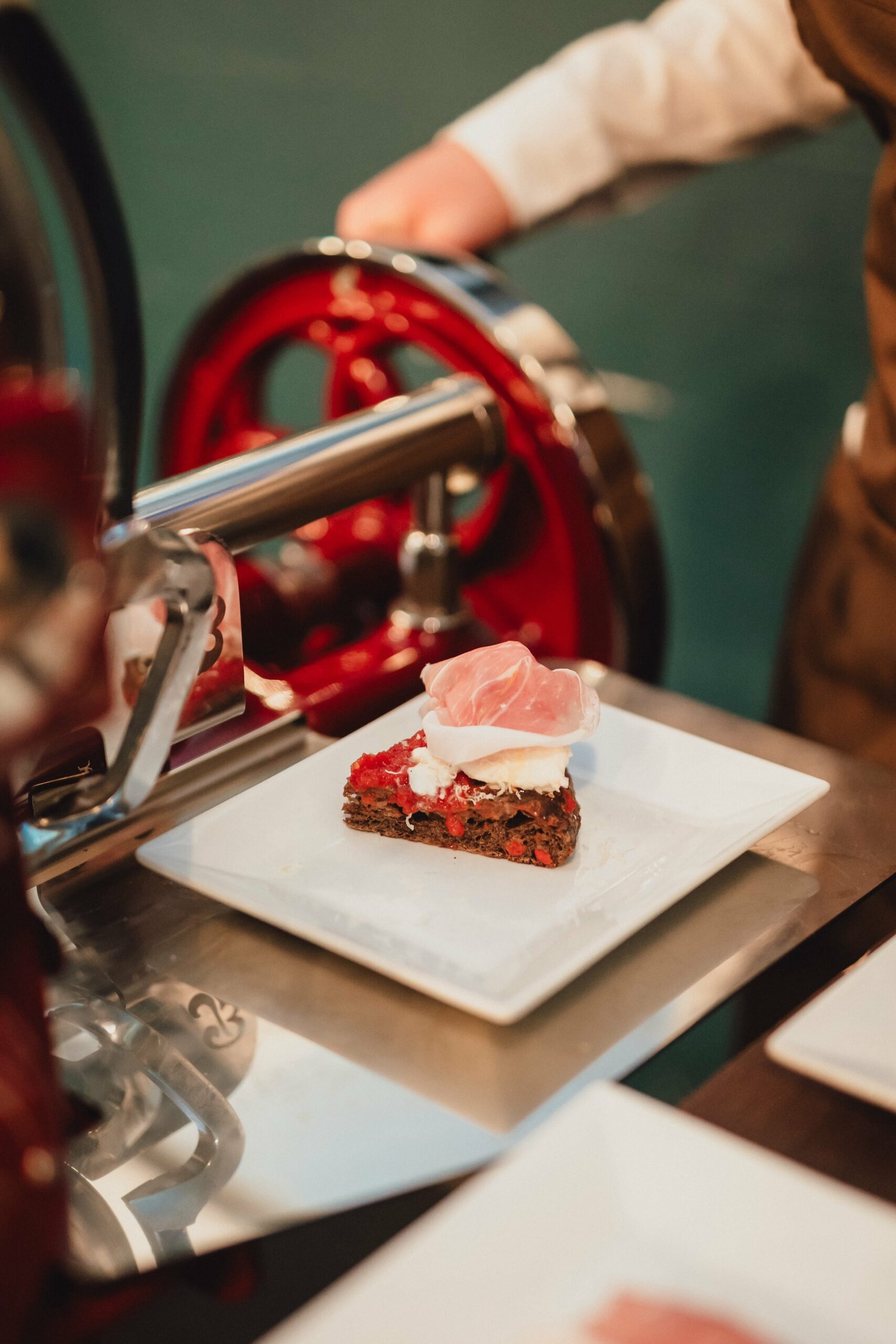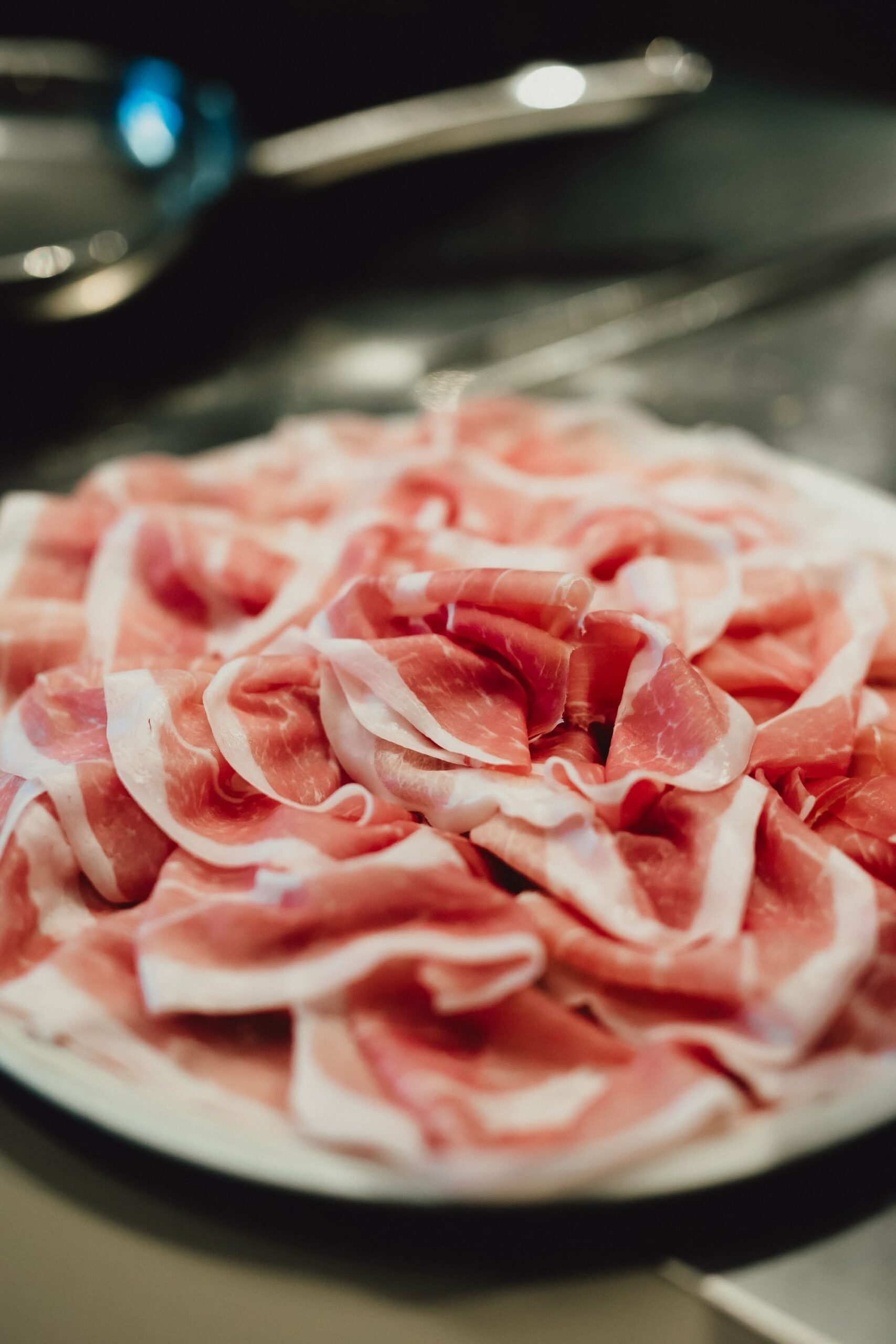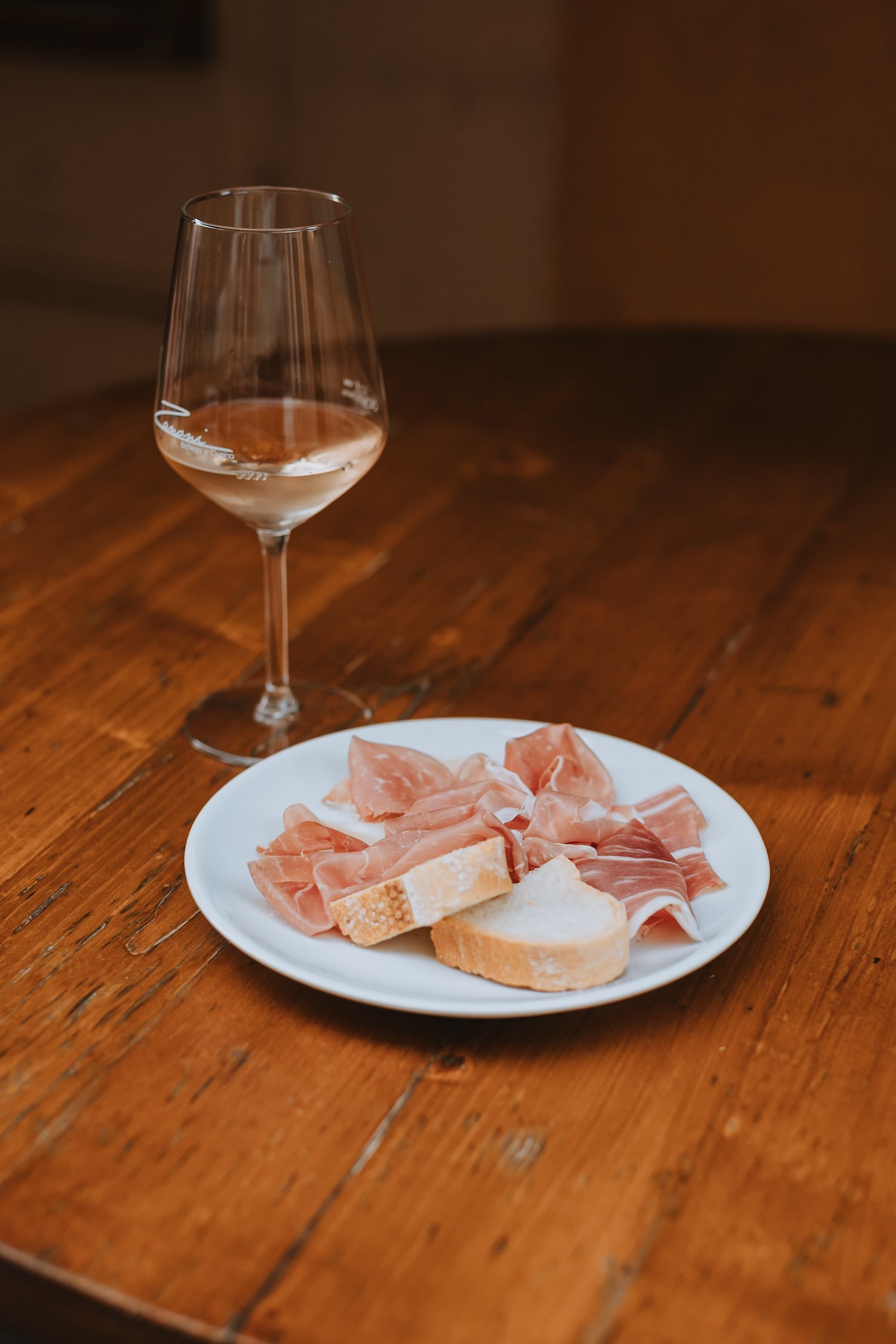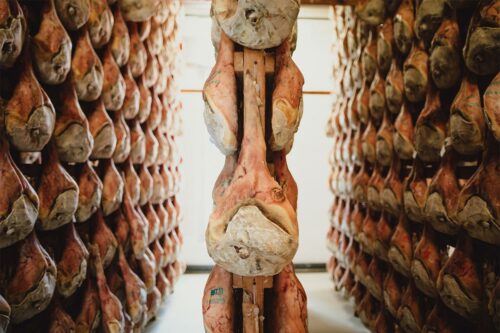A finely cut, rosy-hued slice of ham with an unmistakable aroma. It only takes a moment to recognise Prosciutto di San Daniele, one of Italy’s finest gastronomic products. But behind its apparent simplicity there lies a complex product, the result of time-honoured expertise and a months-long curing process.
That’s why tasting Prosciutto di San Daniele del Friuli means appreciating all its many nuances with care and curiosity. The good news is that you don’t need to be an expert or have any special tools — just trust your senses and know what to pay attention to.
This guide has been created to provide everyone — enthusiasts, curious consumers and lovers of good food — with the knowledge and inspiration needed to experience Prosciutto di San Daniele in a new way. A tasting session will allow you to fully appreciate the qualities of a product crafted according to one of Italy’s oldest culinary traditions.
The look: the 100% natural beauty of Prosciutto di San Daniele PDO
The tasting experience begins well before you take a bite. The first visual clues about the quality of a slice of Prosciutto di San Daniele are easy to spot. Every visual detail — shape, colour, marbling — tells us something about the curing, processing and balance of elements that give this product its unique character.
The lean part of the slice is the first thing to catch your eye. Its typical hue is mellow, uniform and rosy-pink. Carefully controlled ageing and selection means you won’t see any spots or patchiness. Then, gradually, the eye becomes accustomed to the subtler contrasts and recognises the marbling — those slender streaks of fat running through the meat that promise delicacy and roundness on the palate.
The profile of the slice is defined by the surrounding of pure white fat. This gives a sense of completeness to the visual harmony and, even before the actual tasting, communicates to the mouth a certain sweet and velvet anticipation.
Sometimes, small white crystals can be seen on the surface of the slice. Although they resemble grains of salt, they actually indicate tyrosine — a natural amino acid formed during the curing process that is also found in other high-quality products such as long-matured cheeses. Their presence is not a defect but a feature of prolonged maturation.
The aromas of ageing: tasting Prosciutto di San Daniele with all your senses
After sight, smell is the next sense that guides your tasting of Prosciutto di San Daniele. The complexity of the product, cured slowly and naturally and with no additives or added flavourings, begins to reveal itself through its aroma.
Bringing the slice closer to you, you’ll sense its delicate, wholly recognisable aromas. First, milky or buttery notes, linked to the fat content of the ham. Over time, this fat undergoes natural enzymatic transformation, developing aromas that are sweet, mellow and persistent. In some slices, especially those closer to the initial section of the ham, there may also be a scent reminiscent of bread crust. This is typical of areas where the product has had greater exposure to suet (more information on this important stage of the production process can be found in this article).
Sometimes, there’s a more rustic scent, redolent of a wine cellar, and, for many, this is a distinctive sign of craftsmanship, associated with smaller ham producers and traditional curing methods. It isn’t always present, but, when it does emerge, it adds depth and character to the whole.
All these aromas tell the story of the ham: where it was cut, how long it was cured, how it was treated. When tasting Prosciutto di San Daniele, learning to recognise these aromas develops a new awareness based not just on taste, but also on olfactory memory.
The taste: where everything finds perfect harmony
The look and scent of the slice reveal the essence of Prosciutto di San Daniele, but actually tasting it unveils its deepest soul. Sweetness and savouriness come together here, balancing one another to create a unique and unmistakable flavour profile.
Your first bite reveals the sweet notes typical of a naturally cured product with no additives. Immediately afterwards, you’ll discover a delicate savouriness, providing the perfect counterbalance to the sweetness. It’s a sense of harmony created by the presence of the surrounding fat, which softens the perception of salt in the mouth and adds a smooth, melting roundness.
To fully appreciate the product’s characteristics, try a simple experiment: taste a slice with the surrounding fat and then without it. This straightforward yet effective comparison allows you to understand how the structure and sweetness of the ham change depending on its composition.
When tasting Prosciutto di San Daniele, this kind of attentiveness makes all the difference. Every slice tells a story of ageing, balance and raw materials, and it is only through tasting that you can truly appreciate it.

The texture of Prosciutto di San Daniele
As soon as the slice touches the palate, its texture begins to speak. This language of texture, pressure and resistance tells us how long the ham has been cured, how it was cut and which part of the leg it comes from.
The tenderness, melt-in-the-mouth texture and ease with which it can be bitten and chewed are all sensations that emerge when tasting Prosciutto di San Daniele, and they vary from slice to slice. A thin slice melts in the mouth almost effortlessly. A thicker slice, or one that is slightly more mature, has a drier texture and requires slower, more careful chewing.
The anatomy of the slice also plays a role. The tip is leaner and more compact due to the absence of intramuscular fat; the centre is more balanced; and the knuckle area (also known as ‘fiocco’) is aromatic and velvety. This sensation continues in the area known as the ‘culatta’, which is distinguished by its softness and milder saltiness due to the presence of fat. Finally, the shank, or ‘codone’, offers more fibrous slices of ham.
Mindful tasting reveals subtle but significant differences in the texture of the ham’s various areas. Remember that behind every variation lies a story: of cutting, time, and naturalness.
The retronasal perception: sensations that remain
Tasting Prosciutto di San Daniele certainly does not end with swallowing. In fact, one of the most complex and interesting sensations emerges precisely after eating the slice: retronasal perception. This is when the aromas return through the retronasal passage, completing the experience with new nuances.
Retronasal sensations are often deeper and more persistent than the initial ones. They can confirm perceptions from the sense of smell — such as milky notes or rustic hints reminiscent of a cellar — or reveal new, more complex nuances, such as fruity hints or aromas of aged cheese.
This variety is made possible by the interaction between taste and smell receptors. When the ham is well cured and sliced correctly, retronasal perception becomes a kind of sensory echo — an aromatic sensation that lingers over time and continues to be enjoyed even the minutes following the tasting.
What about tasting Prosciutto di San Daniele at home? Read on to find out how to recreate the experience
You don’t need to be in San Daniele del Friuli to enjoy an authentic tasting experience — although if you have the opportunity to visit the town of Prosciutto di San Daniele, here you’ll find excellent suggestions on where to taste it. With a few simple tricks, even a slice of ham served at home can be transformed into a meaningful and flavourful experience.
The first tip is simple but essential: serve the ham cold — but if it’s packaged in trays, allowing the product to breathe for a few minutes at room temperature is ideal for releasing all its aromas.
If the ham is sliced on the spot — perhaps from a piece purchased at a deli — thin slices make all the difference. Alternatively, even a good pre-sliced tray can provide an excellent experience, as long as the product is well preserved.
To cleanse the palate between tastings, it’s useful to accompany the ham with raw vegetables such as carrots or fennel. These help neutralise the flavours and prepare the palate for the next bite — especially if you want to compare different slices.
It’s interesting to try slices from different parts of the ham, such as the tip, centre, ‘fiocco’ and ‘culatta’. The differences may be subtle, but they demonstrate the variety and complexity of this product, offering different sensations with each cut.
And for those who want to experience it first-hand in its place of origin, the area offers a variety of options — from a walk through art and flavours in the village (find out more here) to a weekend of tasting and enjoying the great outdoors (here the complete guide).
Pairings: when ham meets other flavours
A mindful tasting experience can also become a shared moment. Bread, fruit, seasonal vegetables, wine, beer or even cocktails can accompany ham without overpowering it, creating flavour combinations that enhance its natural qualities.
Wine is the most classic and obvious choice. Friulian labels, in particular, offer a wide range of options — from fresh, floral white wines such as Friulano or Ribolla Gialla, to light, delicately tannic red wines such as Refosco or Pinot Nero. The ideal choice depends on the ham’s curing and cut, but generally, the important thing is that the wine complements without overpowering.
When tasting Prosciutto di San Daniele del Friuli, wine is often the first accompaniment to complete the experience.
Wholemeal bread, rich in fibre, is perfect for cleansing the palate between tastings and naturally balancing the ham’s salt content. It’s a simple and effective solution suitable for any occasion.
Those who want to try something different can discover the surprising balance between Prosciutto di San Daniele and craft beer — whether light, amber or aromatic, depending on taste and ageing. There are many possibilities, as described in this in-depth article.
The world of cocktails also offers some unexpected pairings, particularly for those seeking fresh and light combinations. Citrus fruits, aromatic herbs and smooth spirits can enhance our prosciutto in an original and contemporary way. For some ideas to try, here is a practical guide.
There are no fixed rules — every pairing is an invitation to explore and discover, even at home.
Conclusion
Tasting is a great way to get to know a product. It involves pausing for a moment, trusting your senses, and allowing the colour, aroma, texture and taste to reveal the story of each slice.
Whether you are in a prosciutteria, a tavern or at home, tasting Prosciutto di San Daniele can become an intentional act that restores the full richness of traditional knowledge — encompassing ageing, the local area and naturalness.
All it takes is a moment of attention. And the desire to be surprised.








